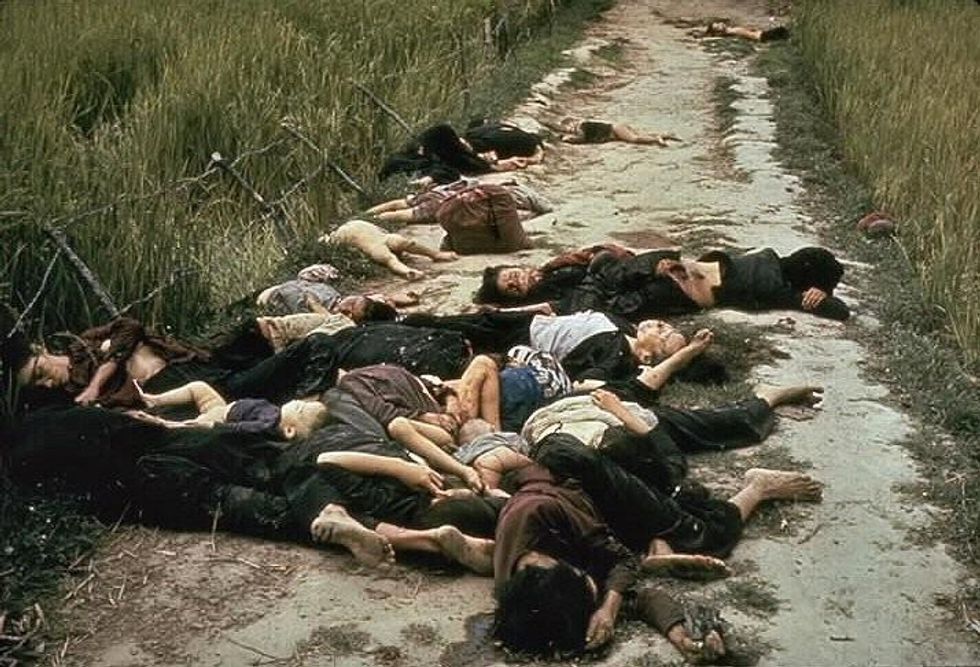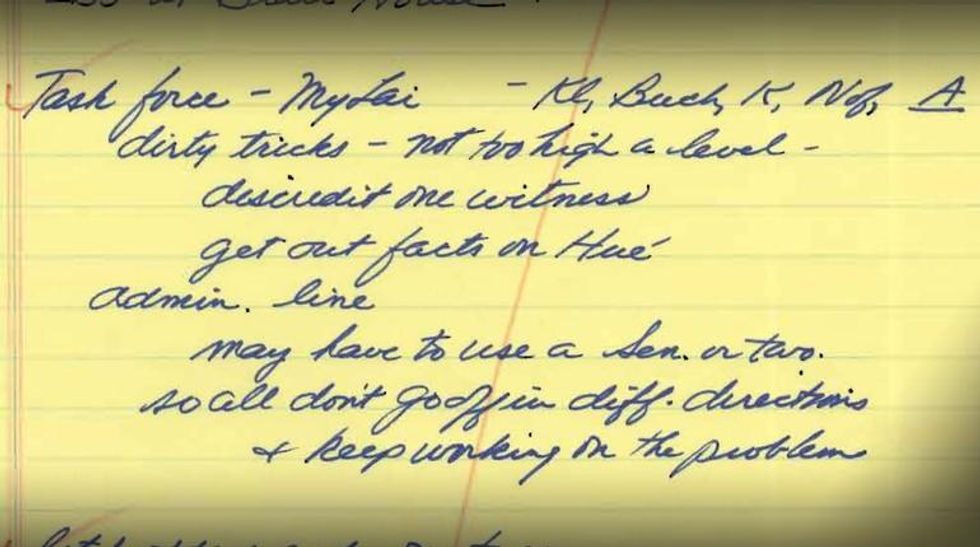Does New Look at Documents Reveal Nixon's Hand in My Lai Cover-Up?
On the 46th anniversary of the massacre, historians say that internal documents reveal presidential interference with war-crime prosecution

Handwritten notes by Nixon's chief of staff H.R. "Bob" Haldeman taken during a December 1, 1969 meeting with the president read: "Task force - My Lai," adding beneath "dirty tricks [...] not too high a level" and "discredit one witness," in order to "keep working on the problem."
The note "reads like a threatening to-do list," writes Salomon.
Ken Hughes, a researcher with the University of Virginia's Miller Center Presidential Recording Program, told Salomon that "Haldeman's note is an important piece of evidence that Nixon interfered with a war-crime prosecution."
Marking the 46th anniversary of the March 16 My Lai massacre, Salomon spoke with a number of historians who conclude that these documents are evidence that Nixon attempted to sabotage the court-martial trials by burying the testimony of American helicopter pilot Hugh Thompson--who witnessed the massacre and attempted to report on the slaughter of hundreds of unarmed men, women and children.

Salomon reports:
Thompson testified about the massacre in the U.S. government's court-martial trials, but according to author Trent Angers, two Congressmen who were working in concert with Nixon, managed to seal that testimony in order to damage the cases against the culprits of My Lai. Whether it was one of the "dirty tricks" Nixon prescribed in Haldeman's 1969 meeting note is a matter of debate for historians.
James Rife, a senior historian at History Associates Inc., helped author Trent Angers find the Haldeman meeting notes, which are described in detail in "The Forgotten Hero of My Lai."
"I would not characterize [the "dirty tricks" note] as a smoking gun, but it's pretty strong," Rife says. "I don't think we'll ever find an actual document that can make the absolute final link between Nixon and Hugh Thompson."
According to historian Ken Hughes, it's the historical context that makes for a convincing argument. He calls My Lai "a political threat to Nixon," and points out that a substantial part of Nixon's support base refused to believe that killing civilians in a war zone was a crime. According to Hughes, Nixon's approval rating dropped by 10 points after Lieutenant William Calley received a life sentence for murdering civilians at My Lai.
_____________________
An Urgent Message From Our Co-Founder
Dear Common Dreams reader, The U.S. is on a fast track to authoritarianism like nothing I've ever seen. Meanwhile, corporate news outlets are utterly capitulating to Trump, twisting their coverage to avoid drawing his ire while lining up to stuff cash in his pockets. That's why I believe that Common Dreams is doing the best and most consequential reporting that we've ever done. Our small but mighty team is a progressive reporting powerhouse, covering the news every day that the corporate media never will. Our mission has always been simple: To inform. To inspire. And to ignite change for the common good. Now here's the key piece that I want all our readers to understand: None of this would be possible without your financial support. That's not just some fundraising cliche. It's the absolute and literal truth. We don't accept corporate advertising and never will. We don't have a paywall because we don't think people should be blocked from critical news based on their ability to pay. Everything we do is funded by the donations of readers like you. Will you donate now to help power the nonprofit, independent reporting of Common Dreams? Thank you for being a vital member of our community. Together, we can keep independent journalism alive when it’s needed most. - Craig Brown, Co-founder |

Handwritten notes by Nixon's chief of staff H.R. "Bob" Haldeman taken during a December 1, 1969 meeting with the president read: "Task force - My Lai," adding beneath "dirty tricks [...] not too high a level" and "discredit one witness," in order to "keep working on the problem."
The note "reads like a threatening to-do list," writes Salomon.
Ken Hughes, a researcher with the University of Virginia's Miller Center Presidential Recording Program, told Salomon that "Haldeman's note is an important piece of evidence that Nixon interfered with a war-crime prosecution."
Marking the 46th anniversary of the March 16 My Lai massacre, Salomon spoke with a number of historians who conclude that these documents are evidence that Nixon attempted to sabotage the court-martial trials by burying the testimony of American helicopter pilot Hugh Thompson--who witnessed the massacre and attempted to report on the slaughter of hundreds of unarmed men, women and children.

Salomon reports:
Thompson testified about the massacre in the U.S. government's court-martial trials, but according to author Trent Angers, two Congressmen who were working in concert with Nixon, managed to seal that testimony in order to damage the cases against the culprits of My Lai. Whether it was one of the "dirty tricks" Nixon prescribed in Haldeman's 1969 meeting note is a matter of debate for historians.
James Rife, a senior historian at History Associates Inc., helped author Trent Angers find the Haldeman meeting notes, which are described in detail in "The Forgotten Hero of My Lai."
"I would not characterize [the "dirty tricks" note] as a smoking gun, but it's pretty strong," Rife says. "I don't think we'll ever find an actual document that can make the absolute final link between Nixon and Hugh Thompson."
According to historian Ken Hughes, it's the historical context that makes for a convincing argument. He calls My Lai "a political threat to Nixon," and points out that a substantial part of Nixon's support base refused to believe that killing civilians in a war zone was a crime. According to Hughes, Nixon's approval rating dropped by 10 points after Lieutenant William Calley received a life sentence for murdering civilians at My Lai.
_____________________

Handwritten notes by Nixon's chief of staff H.R. "Bob" Haldeman taken during a December 1, 1969 meeting with the president read: "Task force - My Lai," adding beneath "dirty tricks [...] not too high a level" and "discredit one witness," in order to "keep working on the problem."
The note "reads like a threatening to-do list," writes Salomon.
Ken Hughes, a researcher with the University of Virginia's Miller Center Presidential Recording Program, told Salomon that "Haldeman's note is an important piece of evidence that Nixon interfered with a war-crime prosecution."
Marking the 46th anniversary of the March 16 My Lai massacre, Salomon spoke with a number of historians who conclude that these documents are evidence that Nixon attempted to sabotage the court-martial trials by burying the testimony of American helicopter pilot Hugh Thompson--who witnessed the massacre and attempted to report on the slaughter of hundreds of unarmed men, women and children.

Salomon reports:
Thompson testified about the massacre in the U.S. government's court-martial trials, but according to author Trent Angers, two Congressmen who were working in concert with Nixon, managed to seal that testimony in order to damage the cases against the culprits of My Lai. Whether it was one of the "dirty tricks" Nixon prescribed in Haldeman's 1969 meeting note is a matter of debate for historians.
James Rife, a senior historian at History Associates Inc., helped author Trent Angers find the Haldeman meeting notes, which are described in detail in "The Forgotten Hero of My Lai."
"I would not characterize [the "dirty tricks" note] as a smoking gun, but it's pretty strong," Rife says. "I don't think we'll ever find an actual document that can make the absolute final link between Nixon and Hugh Thompson."
According to historian Ken Hughes, it's the historical context that makes for a convincing argument. He calls My Lai "a political threat to Nixon," and points out that a substantial part of Nixon's support base refused to believe that killing civilians in a war zone was a crime. According to Hughes, Nixon's approval rating dropped by 10 points after Lieutenant William Calley received a life sentence for murdering civilians at My Lai.
_____________________

